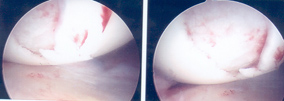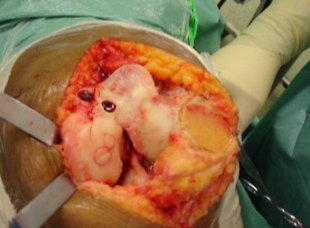Articular cartilage is the hard smooth gristle that covers the ends of the bone and provides the smooth hard wearing covering that enables all our joints to move fully, smoothly and without pain. A "torn cartilage" is not a tear in the gristle layer it is a tear in the pad or meniscus of the knee. This is a relatively common problem and easily treated.
When areas of articular cartilage are lost it cannot be replaced and the resulting defect can only be filled with scar tissue. The treatment may therefore may be quite difficult.
 How is articular cartilage damaged?
How is articular cartilage damaged?
People may have an injury that damages the articular cartilage. The same injury may cause a meniscal tear or a ligament injury. Some people may have "weak" articular cartilage as a genetic trait and therefore the cartilage maybe more prone to injury.
What does cartilage damage feel like?
Articular cartilage damage may cause pain, swelling, catching ,giving way or locking.The problems caused by articular cartilage damage are not specific to this conditonand therefore the diagnosis may be very difficult
How is the diagnosis made?
The other difficulty is that articular cartilage injuries are difficult to image. They will not show on Xray and may not show on MRI scans. Developments in MRI scans will in the future enable us to identify defects more accurately and to monitor healing of these defects. Most cartilage injuries are diagnosed at the time of arthroscopy.
 How are they treated?
How are they treated?
When loss of articular cartilage becomes extensive and loss occurs on both sides of the joint so the bones are touching; this is arthritis. The current knowledge would suggest that these lesions should be treated in order to prevent arthritis in the future.
There are several novel ways of filling these defects including injecting cartilage cells (Chondrocyte implantation) and grafting dowels of cartilage and bone into the defect(osteochondral transplantation). The other common method is to drill the defect or use special pics to make small holes in the bone to stimulate scar tissue fill into the defect(microfracture).
The recovery from this surgery is prolonged and may vary from 3 to 36 months.
These treatments are still experimental and in some circumstances are part of clinical trials.
Research work is ongoing on improving these treatments and new developments and advances are occurring all the time.
Articular cartilage damage may also be associated with ligament damage and meniscal tears. Therefore a thorough assessment of these articular cartilage defects is essential in order to plan any surgical reconstruction.
Degeneration of articular cartilage or gristle is a normal ageing process and maybe linked to each individual's genetics. Degenerative cartilage loss may not be suitable for reconstructive operations. Established arthritis is a contraindication to this type of surgery.
When degeneration of articular cartilage progresses and leads to exposure of bone in the joint this is when arthritis develops. There are no obvious methods of slowing the degenerative process in articular cartilage, but keeping body weight under control and maintaining an exercise and muscle strengthening program are thought to be helpful.
Back to top